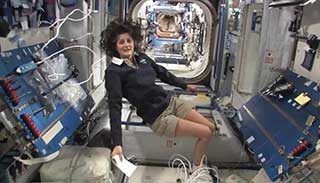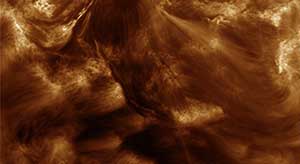
Light on the Dark Side: Images
and Reflections from Outer Space
- Phil MacGregor
_______________________________

Fig. 14. The International Space Station 

Fig. 15. Sunita Williams on the ISS, 2012 

Empirical support for such basic tourist sentiment occurs in online comments. A view of Saturn close-up in Cosmic Log
is so beautiful that it literally made me get teary eyed. I just wish we could figure out a practical way to send humans out there to see that in person. We need a warp drive. Otherwise, it just won't happen (Cosmic Log: March 2013).
Another commentator applauds “stunning images of Saturn's delicate rings as never seen before look so real, one wants to reach out and touch them” (Cosmic Log: March 2013). This materializing wish and crude tactile intention falls into the realm of exchange relationships and commodification.
While the tourism interpretations and commodification can be applied to many instances, including photographic work of astronauts as proxy tourists, a further theme of imagery links to fetishism of technologies, such as this photo of the International Space Station above earth (fig. 14). The aesthetic combines idealisation and technology fetishism. Stark clear outlines of floating apparatus, typically etched in light against a dark background of space, glamorize the technological object. Moments captured of spaceships docking seem to diminish the hostility of the neighbouring environment while incarnating a fusion of science fact and fiction. These are delicate high-definition wonders of space technology and digital communication combined. They evoke tropes of progress and scientific power that allow the public a vicarious pleasure in achievement and a chance to share technological opinions about the spacecraft systems. Kessler (Op. cit.) ties them to the “machine aesthetic” of modernism. Similar echoes of such glamorized visions are captured in artists' illustrations of space vehicles before they are complete. The aesthetic is visionary as the photos celebrate of the extensions of senses through instrumentation.
Faculty of Pleasure
If one part of the visualization of space activity appeals to a faculty of pleasure, there are others celebrating other kinds of information or fact. The websites in this discussion publish many space images whose primary intent is not aesthetic — they include images containing a variety of information, of human endeavour, of significant events such as the docking of private companies' craft or Russian Soyuz rockets with the International Space Station. Some are of pure science, such as space geology, astronomy, cosmology or images linked to unsolved mysteries like the nature or origin of dark energy or dark matter — questions of astrophysics.
The images link some conventional news values, displaying the human factor, or being timely, and fitting the news cycle (rocket launches and arrivals), or being in some way portrayed as sensational as an act of discovery (Hansen, art. cit.).
Few of the image categories are really discrete. There are five themes separating the still images: These are: a) aesthetically pleasing pictures of space objects/events and b) pictures relayed for their scientific significance, as evidence. They are denotative, showing rock surfaces, asteroid surfaces etc., which need little interpretation. There are, then c) quite different human social pictures, such as astronauts in space (fig. 15). A fourth type d) depicts events in space as human technologies in action (dockings, launches, Shuttle movements, satellites) and a fifth category e) is of events that are non-human, such as sunspots erupting. The latter sort cannot be deciphered without considerable explanation. This close-up of the sun could be anything (fig. 16). Text is paramount in interpretation of many space events and visual material.
The sentiment of awe is often entwined even with the dullest depiction, as is the case of the “self-portraits” of the Curiosity rover set in arid Martian terrain. They exact admiration through definitional power and human achievement.
The Place of Videos
Videos form an integral part of online space journalism — in the case of the Guardian and New York Times, a slot for them was structured into the page layout at the time of sampling. Of the analysed sample, they are least frequent in Le Figaro. They can be separated roughly into those that directly record physical happenings — dockings, launches and rocket returns, or unique astronomical events — and didactic explanatory videos about technology or physics [20], or ones that simulate a satellite's purposes and journeys, or that elucidate physical or astronomical processes. Examples of the physical type are of a parachute flapping in Martian breeze, or a collision of an asteroid with a planet. For explanatory stories, you can see replications of collisions with high velocity bits of space junk. Often they deploy still images and graphic simulation. Videos include much less primary evidence than the static camera imagery and show fewer scientific shots and observations than from telescope images and those of cameras. Perhaps this is because they are not part of pure scientific work. The explanatory videos include standard broadcast formats — packages, with voice to camera, interviewees and interwoven footage or images. Their purpose is to illustrate processes or planned space mission events such as computer simulations of NASA's plan to catch an asteroid. They rarely connect directly to aesthetics, but work within a theme of familiarization of space that connects it to the popularization of science. Somehow, the exotic or sublime characteristics of space are comparatively slight in this medium.
A special type of video features the astronaut as author. Such a being becomes a kind of citizen astronaut. The prime example is Chris Hadfield, who was in 2013 heading the International Space Station team in space. His videos are personalised didactic stories about his life and observations inside or from the space station, sometimes aimed at a child audience. One shows the procedure for brushing your teeth in zero gravity, and another tells of the most hair-raising moments he can recall in space. He is, in a sense, a proxy journalist — a citizen journalist from space, having power of direct witness and experience and exploiting a unique vantage point. His videos personalize space, so the imagery acts to familiarize the extra-terrestrial environment. His eye-in-the-sky advantage has its limits: he is still no nearer astronomical events in light year terms!
A less vivid case is of an amateur video that showed four seconds of an astronomical body hitting Jupiter. Stories, stills and videos from amateurs (or citizen journalists as they might now be termed) are rare, only about two percent of the total web content, but it is notable they attract untypically large numbers of Twitter and Facebook shares.
[20] Ian Sample, “What is the Higgs Boson?” The Guardian, July 3, 2012, (accessed July 3, 2014).


